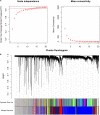Bioinformatics Analysis of Prognostic miRNA Signature and Potential Critical Genes in Colon Cancer
- PMID: 32582275
- PMCID: PMC7296168
- DOI: 10.3389/fgene.2020.00478
Bioinformatics Analysis of Prognostic miRNA Signature and Potential Critical Genes in Colon Cancer
Abstract
This study aims to lay a foundation for studying the regulation of microRNAs (miRNAs) in colon cancer by applying bioinformatics methods to identify miRNAs and their potential critical target genes associated with colon cancer and prognosis. Data of differentially expressed miRNAs (DEMs) and genes (DEGs) downloaded from two independent databases (TCGA and GEO) and analyzed by R software resulted in 472 DEMs and 565 DEGs in colon cancers, respectively. Next, we developed an 8-miRNA (hsa-mir-6854, hsa-mir-4437, hsa-mir-216a, hsa-mir-3677, hsa-mir-887, hsa-mir-4999, hsa-mir-34b, and hsa-mir-3189) prognostic signature for patients with colon cancer by Cox proportional hazards regression analysis. To predict the target genes of these miRNAs, we used TargetScan and miRDB. The intersection of DEGs with the target genes predicted for these eight miRNAs retrieved 112 consensus genes. GO and KEGG pathway enrichment analyses showed these 112 genes were mainly involved in protein binding, one-carbon metabolic process, nitrogen metabolism, proteoglycans in cancer, and chemokine signaling pathways. The protein-protein interaction network of the consensus genes, constructed using the STRING database and imported into Cytoscape, identified 14 critical genes in the pathogenesis of colon cancer (CEP55, DTL, FANCI, HMMR, KIF15, MCM6, MKI67, NCAPG2, NEK2, RACGAP1, RRM2, TOP2A, UBE2C, and ZWILCH). Finally, we verified the critical genes by weighted gene co-expression network analysis (WGCNA) of the GEO data, and further mined the core genes involved in colon cancer. In summary, this study identified an 8-miRNA model that can effectively predict the prognosis of colon cancer patients and 14 critical genes with vital roles in colon cancer carcinogenesis. Our findings contribute new ideas for elucidating the molecular mechanisms of colon cancer carcinogenesis and provide new therapeutic targets and biomarkers for future treatment and prognosis.
Keywords: GEO; TCGA; bioinformatics; biomarker; colon cancer; microRNA; prognosis.
Copyright © 2020 Chen, Gao, Liu, Wen, Hong and Huang.
Figures







Similar articles
-
Bioinformatics Analysis of a Prognostic miRNA Signature and Potential Key Genes in Pancreatic Cancer.Front Oncol. 2021 May 20;11:641289. doi: 10.3389/fonc.2021.641289. eCollection 2021. Front Oncol. 2021. PMID: 34094925 Free PMC article.
-
Identification of Differentially Expressed Genes and miRNAs Associated with Esophageal Squamous Cell Carcinoma by Integrated Analysis of Microarray Data.Biomed Res Int. 2020 Jul 1;2020:1980921. doi: 10.1155/2020/1980921. eCollection 2020. Biomed Res Int. 2020. PMID: 32714975 Free PMC article.
-
Bioinformatics Analysis Identifies the Estrogen Receptor 1 (ESR1) Gene and hsa-miR-26a-5p as Potential Prognostic Biomarkers in Patients with Intrahepatic Cholangiocarcinoma.Med Sci Monit. 2020 May 21;26:e921815. doi: 10.12659/MSM.921815. Med Sci Monit. 2020. PMID: 32435051 Free PMC article.
-
Gastric Cancer MicroRNAs Meta-signature.Int J Mol Cell Med. 2019 Spring;8(2):94-102. doi: 10.22088/IJMCM.BUMS.8.2.94. Epub 2019 Aug 24. Int J Mol Cell Med. 2019. PMID: 32215261 Free PMC article. Review.
-
Bioinformatics Resources for MicroRNA Discovery.Biomark Insights. 2016 Jan 18;10(Suppl 4):53-8. doi: 10.4137/BMI.S29513. eCollection 2015. Biomark Insights. 2016. PMID: 26819547 Free PMC article. Review.
Cited by
-
Treatment of Cancer Gene Changes in Chronic Myeloid Leukemia by Big Data Analysis Platform-Based Dasatinib.Appl Bionics Biomech. 2022 Jun 10;2022:9294634. doi: 10.1155/2022/9294634. eCollection 2022. Appl Bionics Biomech. 2022. Retraction in: Appl Bionics Biomech. 2023 Nov 29;2023:9804128. doi: 10.1155/2023/9804128. PMID: 35721237 Free PMC article. Retracted.
-
Expression Analysis of miR-519a-3p and miR-379-5p in Colorectal Cancer Patients: A Combined Experimental and Bioinformatic Approach.Diagnostics (Basel). 2025 Aug 13;15(16):2023. doi: 10.3390/diagnostics15162023. Diagnostics (Basel). 2025. PMID: 40870875 Free PMC article.
-
Explore Key Genes and Mechanisms Involved in Colon Cancer Progression Based on Bioinformatics Analysis.Appl Biochem Biotechnol. 2024 Sep;196(9):6253-6268. doi: 10.1007/s12010-023-04812-3. Epub 2024 Jan 31. Appl Biochem Biotechnol. 2024. PMID: 38294732
-
Pan-cancer analysis of the immune aspects and prognostic value of NCAPG2.Heliyon. 2023 Jul 13;9(7):e18051. doi: 10.1016/j.heliyon.2023.e18051. eCollection 2023 Jul. Heliyon. 2023. PMID: 37501987 Free PMC article.
-
Molecular mechanism of colorectal cancer and screening of molecular markers based on bioinformatics analysis.Open Life Sci. 2023 Nov 10;18(1):20220687. doi: 10.1515/biol-2022-0687. eCollection 2023. Open Life Sci. 2023. PMID: 37954103 Free PMC article.
References
LinkOut - more resources
Full Text Sources
Research Materials
Miscellaneous

